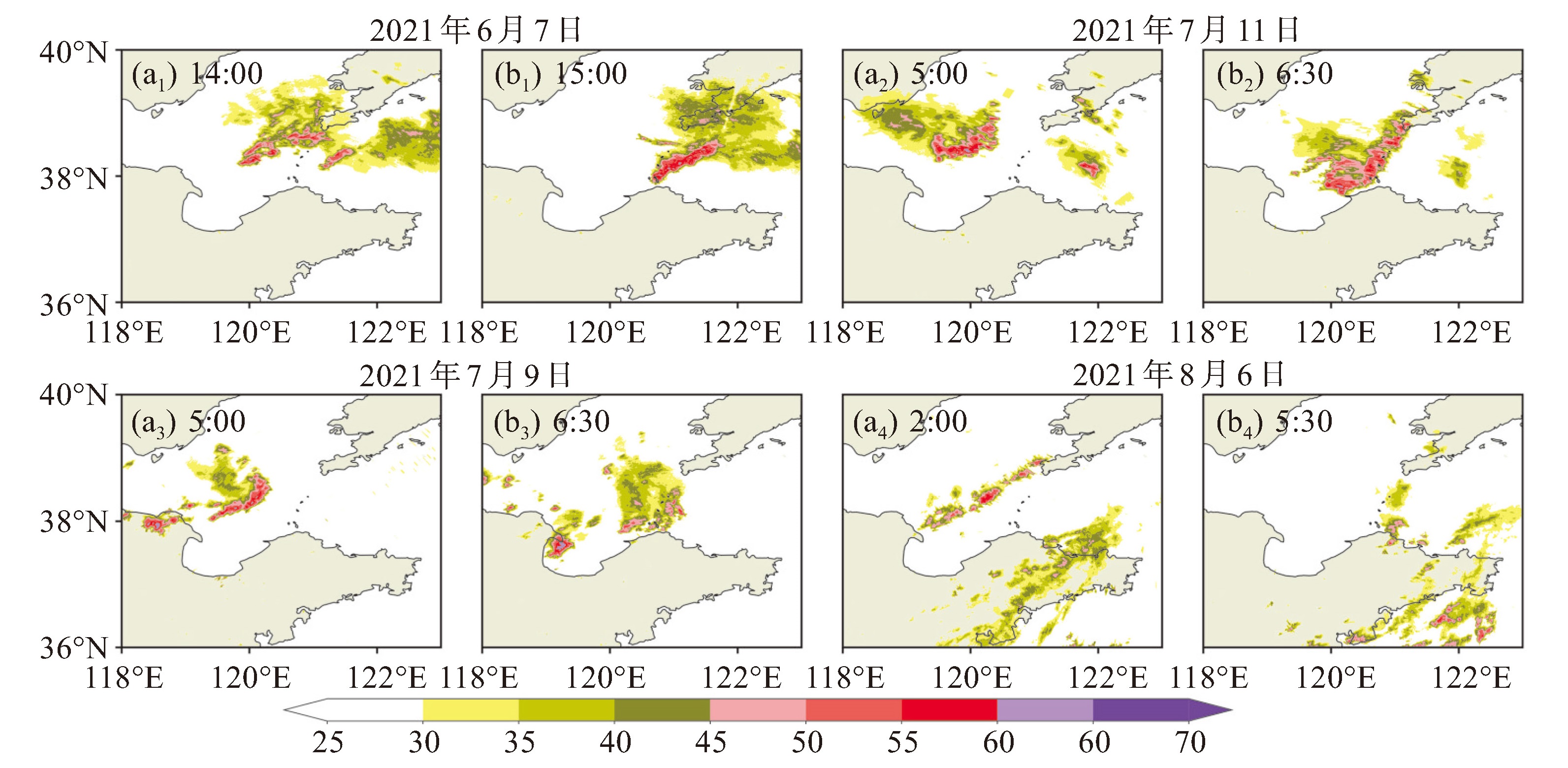Effects of the Underlying Surface on the Intensity of Linear Storms in the Bohai Strait
-
摘要: 利用常规观测资料、雷达资料和ERA5再分析数据,结合2021年渤海海峡两类不同演变特征的强对流个例,分析了下垫面对线性风暴强度的影响。结果表明:增强、减弱过程均发生在弱天气尺度系统影响下,低层均伴有暖温脊,有利于位势不稳定层结的建立。夜间弱天气系统影响时,下垫面温度不均带来的热力环流和动力强迫起主要作用,白天海面温度差异引起的下垫面作用是次要的。一般情况下,夜间线性风暴东移至渤海海峡时,受渤海海峡冷水区上空的辐散气流影响减弱。当下垫面温度不均引起的近海层上升运动与环境辐合上下同位相叠加时,风暴增强。这种情况下,渤海海峡附近有暖水区上升、冷水区下沉的近海层相对浅薄的中尺度次级环流,环境辐合多有周围其他风暴的下沉出流与环境风辐合抬升形成。此外,环境偏东气流及0-1km较强垂直风切变有利于线性风暴移动方向上升运动的维持;海陆风与海岸线曲率也对沿海对流有影响。Abstract: Using observational data, radar data, and ERA5 reanalysis data, this study analyzed the impact of the underlying surface on the intensity of linear storms in the Bohai Strait through the analysis of two severe convective events with distinct evolutionary characteristics in 2021. The results show that both storm strengthening and weakening occurred under weak synoptic forcing, with low-level warm temperature ridge supporting potential instability stratification. Nocturnal thermal circulation and dynamic forcing dominated storm modulation through surface thermal heterogeneity, while daytime sea surface temperature (SST) gradients played secondary roles. Eastward-moving nocturnal linear storms typically weakened over the Bohai Strait cold-water region due to divergent flows. Storm enhancement occurred when ascent in the near-surface layer (induced by surface thermal contrasts) vertically aligned with environmental convergence. In this case, a relatively shallow mesoscale secondary circulation developed near the Bohai Strait, characterized by ascending motion in warm water areas and descending motion in cold water regions within the near-surface layer. Environmental convergence was often caused by outflows of other surrounding storms lifted by environmental wind convergence. Additionally, environmental easterly airflow and strong vertical wind shear at 0-1 km were conducive to maintaining the ascending motion of linear storm movement; sea breeze and coastline curvature also affected coastal convection.
-
表 1 四次过程对流回波时空变化特征和700 hPa的Q矢量散度最小值(单位:10-15 hPa-1·s-3)
过程 初始回波 渤海海峡西部 渤海海峡 Q矢量散度 位置 时间 时间 类型 时间 强度变化 “6.7” 渤海中部 11:00前 12:00 线性风暴 12:00—16:00 持续增强 -2.96 “7.10” 京津冀 02:00前 5:00 飑线 05:00—08:00 先减弱后增强 -1.88 “7.8” 渤海西部 03:00前 5:00 弓形回波 05:00—08:00 明显减弱 -1.06 “8.5” 渤海中西部 01:00前 0.08 线性风暴 02:00—06:00 明显减弱 -0.80 -
[1] FENG Z, LEUNG L R, LIU N, et al. A global high-resolution mesoscale convective system database using satellite-derived cloud tops, surface precipitation, and tracking[J]. J Geophys Res, 2021, 126(8): 1-29. [2] GROSSMAN R L, DURRAN DR. Interaction of low‐level flow with the western Ghat Mountains and offshore convection in the summer monsoon[J]. Mon Wea Rev, 1984, 112(9): 652-672. [3] HOUZE R A, WILTON D C, and SMULL B F. Monsoon convection in the himalayan region as seen by the TRMM precipitation radar[J]. Quart J Roy Meteor Soc, 2007, 133: 1 389-1 411. [4] XIE S, XU H, SAJI N H, et al. Role of narrow mountains in large‐scale organization of Asian monsoon convection[J]. J Climate, 2006, 19 (14): 3 420-3 429. [5] BAI H, SCHUMACHER C. Topographic influences on diurnally driven MJO rainfall over the maritime continent[J]. J Geophys Res, 2022, 127(6): e2021JD0359-05. [6] HODANISH S J, SHARP D W, COLLINS W, et al. A 10-yr monthly lightning climatology of florida: 1986-95[J]. Wea Forecasting, 1997, 12 (3): 439-448. [7] HOUZE Jr R A, GEOTIS S G, MARKS Jr F D, et al. Winter monsoon convection in the vicinity of North Borneo. Part I: Structure and time variation of the clouds and precipitation. Mon Wea Rev, 1981, 109(8): 1 595-1 614. [8] MAPES B E, WARNER T T, XU M, et al. Diurnal patterns of rainfall in northwestern south America. Part I: Observations and context [J]. Mon Wea Rev, 2003, 131(5): 799-812. [9] ZHANG L, SUN J, YING Z, et al. Initiation and development of a squall line crossing Hangzhou Bay. J Geophys Res, 2021, 126(1): e2020JD032504. [10] SHIE C L, TAO W K, SIMPSON J. A note on the relationship between temperature and water vapor over oceans, including sea surface temperature effects[J]. Adv Atmos Sci, 2006, 23(1): 141-148. [11] LERICOS T P, FUELBERG H E, WEISMAN M L, et al. Numerical simulations of the effects of coastlines on the evolution of strong, longlived squall lines. Mon Wea Rev, 2007, 135(5): 1 710-1 731. [12] MURRAY J C, COLLE B A, The spatial and temporal variability of convective storms over the northeast United States during the warm season[J]. Mon Wea Rev, 2011, 139(139): 992-1 012. [13] LOMBARDO K A, COLLE B A. Ambient conditions associated with the maintenance and decay of quasi-Linear convective systems crossing the northeastern U.S. coast[J]. Mon Wea Rev, 2012, 140: 3 805-3 819. [14] WILSON J W, CARBONE R E, TUTTLE J D, et al. Tropical island convection in the absence of significant topography. Part II: Nowcasting storm evolution[J]. Mon Wea Rev, 2001, 129 (7): 1 637-1 655. [15] RANDALL D A, HARSHVARDHAN, DAZLICH D. Diurnal variability of the hydrologic cycle in a general circulation model[J]. J Atmos Sci, 1991, 48(1): 40-62. [16] WARNER T T, LAKHTAKIA M N, DOYLEJ D, et al. Marine atmospheric boundary layer circulations forced by gulf stream sea surface temperature gradients[J]. Mon Wea Rev, 1990, 118(2): 309-323. [17] SMALL R J, DESZOEKE S P, XIE S, et al. Air-sea interaction over ocean fronts and eddies[J]. Dyn Atmos Oceans, 2008, 45(3-4): 274-319. [18] MINOBE S, MIYASHITA M, KUWANO-YOSHIDA A, et al. Atmospheric response to the Gulf Stream: Seasonal variations[J]. J Climate, 2010, 23(13): 3 699-3 719. [19] TOKINAGA H, TANIMOTO Y, XIE S, et al. Ocean frontal effects on the vertical development of clouds over the Western North Pacific: In situ and satellite observations[J]. J Climate, 2009, 22: 4 241-4 260. [20] MINOBE S, KUWANO-YOSHIDA A, KOMORI N, et al. Influence of the Gulf Stream on the troposphere[J]. Nature, 2008, 452(7184): 206- 209. [21] KUWANO-YOSHIDA A, MINOBE S, XIE S. Precipitation response to the Gulf Stream in an atmospheric GCM[J]. J Climate, 2010, 23 (13): 3 676-3 698. [22] LOMBARDO K, COLLE B A. Processes controlling the structure and longevity of two quasi-linear convective systems crossing the southern New England coast[J]. Mon wea Rev, 2013, 141(11): 3 710-3 734. [23] 王彦, 于莉莉, 朱男男, 等. 渤海湾海风锋与雷暴天气[J]. 高原气象, 2011, 30(1): 245-251. [24] 高晓梅, 王世杰, 王文波, 等. 2016年山东一次阵风锋触发的强对流天气分析. 海洋气象学报, 2018, 38(2): 67-75. [25] 屈梅芳, 俞小鼎, 农孟松, 等. 一次弱垂直风切变环境下飑线发展维持的成因分析[J]. 暴雨灾害, 2021, 40(5): 466-473. [26] BLUESTEIN, H B. Principles of Kinematics and Dynamics. Vol. 1, Synoptic-Dynamic Meteorology in Midlatitudes. Oxford University Press, 1992, 448 pp. [27] 周琰, 刘宣飞, 李智. 海洋锋海表风速最小值及其成因[J]. 热带气象学报, 2017, 33(2): 167-176. [28] 谢傲, 徐海明, 徐蜜蜜, 等. 海表面盛行风背景下大气对黑潮海洋锋的响应特征[J]. 气象科学, 2014, 34(4): 355-364. [29] 李智, 刘宣飞, 李传浩. 大气对春季东海黑潮锋响应的气压调整机制分析[J]. 大气科学, 2015, 6: 1 081-1 094. [30] 俞小鼎, 郑永光. 中国当代强对流天气研究与业务进展[J]. 气象学报, 2020, 78(3): 391-418. [31] CASTRO A, SANCHEZ J L, FRAILE R. Statistical comparison of the properties of thunderstorms in different areas around the Ebro-Valley (Spain)[J]. Atmospheric research, 1992, 28(3-4): 237- 257. [32] 俞小鼎, 周小刚, 王秀明. 雷暴与强对流临近天气预报技术进展[J]. 气象学报, 2012, 70(3): 311-337. [33] 邢秀芹. 胶东半岛地区海陆风特征[J]. 气象, 1997, (5): 56-58. [34] 薛德强, 郑全岭, 钱喜镇, 等. 山东半岛的海陆风环流及其影响[J]. 南京气象学院学报, 1995, 2: 293-299. [35] ROTUNNO R, KLEMP J B, WEISMAN M L. A theory for strong, long-lived squall lines[J]. Je Atm Sci, 1988, 45(3): 463-485. [36] LERICOS T P, FUELBERG H E, WEISMAN M L, et al. Numerical simulations of the effects of coastlines on the evolution of strong, longlived squall lines[J]. Mon Wea Rev, 2007, 135(5): 1 710-1 731. -






 下载:
下载:













 粤公网安备 4401069904700003号
粤公网安备 4401069904700003号